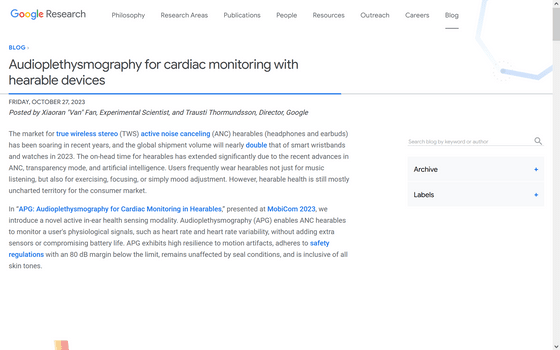Google announces a mechanism to add heart rate detection function to noise canceling earphones with just a software update

Google shared research on ``audio plethysmography (APG),'' which adds heart rate detection function to headphones and earphones equipped with active noise canceling (ANC) by simply adding a simple software update.
Audioplethysmography for cardiac monitoring with hearable devices – Google Research Blog

Google turned ANC earbuds into heart rate sensor
APG works by sending a 'low-intensity ultrasound signal' through the speaker of an ANC-enabled headphone or earphone toward the ear. The signal sent by the speaker causes an echo, which is modulated by small skin displacements in the ear canal and vibrations of the heartbeat. It seems that heart rate can be read by receiving the modulated echoes with a microphone.
Google created a model that can perform the above processing to read heart rate and read heart rate variability (HRV), the interval between heartbeats. This technology is said to work even if music is playing or the earphones have a poor seal.

The external auditory canal is supplied with blood by the deep auricular artery, which forms a complex network that widely penetrates the auditory nerve canal. The slight changes in the shape of blood vessels caused by heartbeat and blood pressure lead to subtle changes in the volume and pressure of the ear canal, making it easier to detect heartbeats from the ear.
Google conducted two studies on 153 people and announced that APG was able to consistently and accurately measure heart rate and heart rate variability.

Recent research is considering packaging a large number of sensors such as ``photoplethysmography (PPG)'' and ``electrocardiogram'' together with a microcontroller and installing them in headphones to measure heart rate and blood pressure. However, since installing such a sensor inevitably leads to increases in cost, weight, and power consumption, there are currently barriers to realization.
Google says, 'With a simple software upgrade, you can transform any ANC headphone into a smart sensing headphone. The signal during processing is invisible to the user and is not affected by music playback.' 'This is a superior approach to conventional photoplethysmography and electrocardiogram sensors,' he said.
Related Posts:
in Hardware, Posted by log1p_kr







